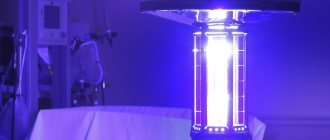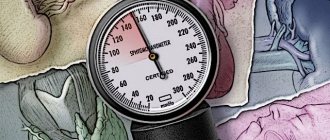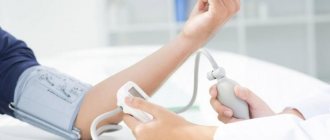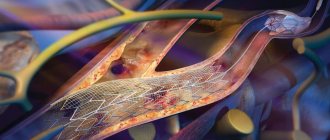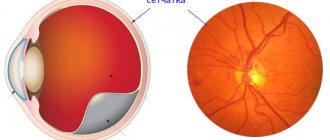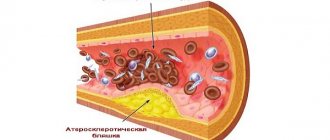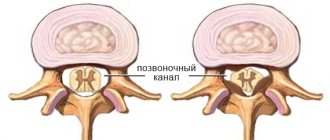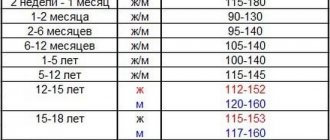Forms of the disease
Physiological
One of the normal options. The disease can develop due to excessive physical activity or when moving to a high mountain region (low blood pressure is observed during the adaptation period).
Pathological
- Primary. It can be reversible or over time take a chronic form, that is, turn into a hypotensive disease, accompanied by dizziness, headaches, etc. It occurs against the background of puberty, stress, overwork, thinness, heredity, etc. Source: K.M. Dzilikhova, M.G. Dzgoeva, Z.D. Kaloeva, S.Ch. Khestanova, A.K. Shavlokhova Primary arterial hypertension in children // Pediatrics, 2010, v. 89, no. 3, pp. 116-122
- Secondary. It manifests itself due to cardiovascular disorders, pathologies of the endocrine system, diseases of the kidneys and adrenal glands, pneumonia, diabetes mellitus, etc. The second reason is certain drugs, after discontinuation of which arterial hypotension goes away. Source: N.N. Arkhipova Arterial hypotension in children and adolescents // Practical Medicine, 2008, No. 4(28), pp. 63-65
When there is nowhere lower. Understanding the causes of hypotension
A feeling of “lightheadedness” after a stuffy bus, fatigue after a long night’s sleep, “goosebumps” before the eyes after abruptly getting out of bed... These and other symptoms may indicate a decrease in blood pressure - hypotension. And if numerous studies have been devoted to hypertension and treatment principles have been well developed, then with hypotension not everything is so obvious.
What is it, what causes it, how is it recognized and treated? We are talking about this with our permanent consultant, general practitioner, cardiologist at Clinic Expert Voronezh, Kalinina Angelina Anatolyevna.
— Angelina Anatolyevna, what is hypotension? Is this a diagnosis or a syndrome?
Hypotension is low blood pressure. It can be either just a symptom or a diagnosis.
What does “low blood pressure” mean? This is a condition in which blood pressure numbers are lower than expected for a person in a given situation. And what’s interesting: even if the pressure dropped by 20-30 mmHg. and at the same time remained within the normal range, but the person began to feel worse, then this condition can also be regarded as hypotension.
Read the material on the topic: What should a child’s blood pressure be?
Hypotension can be physiological or pathological. Physiological is a variant of the norm. It may, for example, occur in trained athletes, people living in high mountains or hot climates.
Pathological hypotension. These include essential (or primary) hypotension (hypotonic disease), symptomatic (or secondary) hypotension, as well as idiopathic orthostatic hypotension.
Below normal is:
blood pressure below 100/60 mm Hg. Art. in men and 95/60 mm Hg. Art. among women
according to other data - pressure below 100/60 mmHg. in people under 25 years of age, and below 105/65 mmHg. - over 30 years old
The most common pathological condition is essential hypotension. It is expressed by a steady decrease in blood pressure with characteristic manifestations.
Secondary hypotension is a consequence of another disease or drug use.
— What is low blood pressure? At what numbers can we say that the pressure is below normal?
According to some data, blood pressure is below 100/60 mm Hg. Art. in men and 95/60 mm Hg. Art. among women; according to others - pressure below 100/60 mmHg. in people under 25 years of age, and below 105/65 mmHg. - over 30 years old. Moreover, hypotension is said to occur when both indicators (“upper” and “lower” pressure) or one of them decrease.
— High blood pressure threatens a heart attack or stroke. Why is low blood pressure dangerous?
There is an opinion that with an excessive decrease in blood pressure there is also a risk of developing cardiovascular complications, although studies with the required level of evidence have not been conducted.
With age, hypotension may disappear, giving way to arterial hypertension.
In most cases, the prognosis is favorable. If there are no complaints related to low blood pressure, and the person is adapted to it, then hypotension does not cause much harm to the body.
Read the material on the topic: Spinning until you drop! Why do you get dizzy?
The concern is the progression of the disease, repeated episodes of fainting (and possible falls associated with them), the presence of other concomitant pathologies (coronary heart disease, diabetes mellitus, etc.), as well as the patient’s advanced age (risk of falls, deterioration of blood supply to the brain).
— At what blood pressure levels should you urgently call a doctor? Where is the lowest limit?
Everything here is individual. Those. pressure that is low for one may be normal for another (especially if we are talking about hypotension). Therefore, it is quite difficult to voice the limit of the lowest norm.
However, if the patient has symptoms indicating the development of a threatening condition (pain in the heart or chest, shortness of breath, arrhythmic pulse, vomiting, convulsions, impaired consciousness), this is a reason to call an ambulance with possible hospitalization.
— What does a person experience with low blood pressure? What are the symptoms of hypotension?
The most common manifestations of hypotension are general weakness, fatigue, headaches, a tendency to dizziness, pre- and fainting states. There may also be irritability and deterioration in performance (which, with essential hypotension, is often noted already in the morning). Poor tolerance to transport, stuffiness, heat, movement on an escalator, staying at heights. Nausea, impaired thermoregulation (“chilliness”), sweating, fluctuations in blood pressure - from low to high). Difficulty absorbing information, sleep disorders, noise in the head.
Meteorological conditions, etc. may be reported.
Read material on the topic: What is weather dependence: diagnosis or fiction?
Symptoms of hypotension are more common in young, thin women. They often experience anxiety and low mood.
When collecting anamnesis, hereditary burden may be revealed, i.e. existing or existing cases of low blood pressure in the family.
— What leads to the development of hypotension? For what reasons does this condition develop?
The mechanisms of development of essential hypotension are not fully understood. There are suggestions that it is based on a violation of the so-called neuro-humoral regulation of blood circulation. Hereditary burden is often traced, usually through the female line.
There are many causes of secondary hypotension. It can occur when:
- some endocrine pathologies (reduced function of the thyroid gland - hypothyroidism, adrenal cortex - Addison's disease, autonomic diabetic neuropathy, weakened function of the anterior pituitary gland);
— diseases of the cardiovascular system (heart rhythm disturbances; mitral valve prolapse; pericarditis; heart defects; heart failure; coronary heart disease);
Read material on the topic: Coronary heart disease: diagnosis and treatment
— infections and intoxications;
- shock of various nature;
— neurological pathologies (traumatic brain injury and its consequences; brain tumors; syringomyelia, etc.);
- prolonged bed rest;
- pregnancy;
- lack of fluid;
- allergic reactions;
- taking various medications (psychotropic - antidepressants, anti-anxiety drugs, for the treatment of insomnia; antiarrhythmic; antihypertensive - reducing high blood pressure; diuretics; for the treatment of ischemia; anesthetics).
— Can hypotension turn into hypertension? Under what conditions can this happen?
Yes. With age, hypotension may disappear, giving way to arterial hypertension. Usually the pressure does not increase too much, but is nevertheless poorly tolerated. Moreover, it is even possible when the pressure numbers are still within the normal range (for example, the upper 130-135 mmHg) and cannot even be formally formulated as hypertension.
Read the material on the topic: It's off scale! Looking for reasons for high blood pressure
However, in a “past” hypotensive patient, they can already cause manifestations of classic arterial hypertension: a feeling of “pulsation” in the head, dizziness, redness of the face, nausea, rapid heartbeat. And this condition may require appropriate treatment (of course, with a very careful individual selection of drugs and dosages).
— What diagnostics do you need to undergo for hypotension in order to identify the cause of low blood pressure?
When diagnosing arterial hypotension, a general analysis of blood and urine is performed, some biochemical parameters are examined (including glucose), blood electrolytes, cortisol, thyroid hormones, ultrasound of the heart and thyroid gland, ECG, and 24-hour blood pressure monitoring are performed.
Read material on the topic: Ultrasound of the heart: when is it prescribed and what will it show?
Other ultrasound, as well as X-ray examinations, fibrogastroduodenoscopy - according to indications.
— It is known that doctors recommend keeping a diary for hypertensive patients. Is it necessary to keep the same diary for hypotensive patients?
Yes, it makes sense.
— Is hypotension treated with medication?
Yes, such treatment exists, but there are not many drugs. Some of them have shown themselves to work well in cases of orthostatic hypotension and essential hypotension with a “smooth”, monotonous course.
In practice, they are used relatively rarely and very carefully.
— What folk methods can help a hypotensive person raise their blood pressure? Do coffee, ginseng or eleutherococcus help with hypotension?
There are a number of studies showing a moderate positive effect on hypotensives of tea, coffee, as well as medications containing caffeine.
More of our articles in the company’s official VKontakte group
Ginseng or Eleutherococcus will also be effective to some extent, but their effect has not been fully studied - there is also no evidence base for them, as well as for the drugs mentioned above.
— Angelina Anatolyevna, what rules and recommendations should a hypotensive patient follow in order to improve the quality of their life and not feel overwhelmed and tired?
It is necessary to try to identify factors that cause a decrease in pressure and try to avoid/exclude them. Among them is sudden standing up (to prevent a decrease in pressure for this reason, you must first sit down, bend over, then raise your body and head, and stand up); long stay in an upright position; being in stuffy rooms, high air temperature; physical work, especially in hot conditions, as well as the possible loss of fluid associated with this (therefore it is necessary to control fluid loss).
You need to get enough rest, sleep, and follow a work schedule.
The diet (or, rather, the principles of nutrition) for hypotension consists of frequent meals in small portions, limiting the intake of hot food and drinks; foods rich in easily digestible carbohydrates. You can increase your salt and liquid intake (up to 2–2.5 liters of liquid, 8–10 g of salt per day).
Read material on the topic: Life without meat: food, philosophy or benefits for the body?
People with hypotension should avoid alcoholic beverages. Carefully monitor the intake of any medications, and be sure to warn your doctor about your tendency to low blood pressure.
It is imperative to look for and treat pathologies in which hypotension is secondary, i.e. is one of the manifestations of the underlying disease.
There are special gymnastics aimed at training vascular tone. Its principle is that a person who is in a horizontal position is transferred to a vertical position for a short time. The pressure decreases at this time. Such cycles are repeated, and the vessels gradually “get used” to maintaining the pressure at the proper level, which is especially important if you are prone to fainting. Such gymnastics should only be performed under the supervision of a qualified specialist.
You may also be interested in:
Why is electroencephalography needed? Complete patient guide
What is hidden behind the diagnosis of dyscirculatory encephalopathy?
Vegetative-vascular dystonia: go there - I don’t know where, cure that - I don’t know what
For reference:
Kalinina Angelina Anatolevna
In 2007 she graduated from the Voronezh State Medical Academy named after. Burdenko.
From 2007 to 2008 she completed an internship in therapy, in 2010 she underwent professional retraining in the specialty “General Medical Practice (Family Medicine)”, and in 2017 – in the specialty “Cardiology”.
Since 2015, he has held the position of general practitioner at Clinic Expert Voronezh. Reception is conducted at the address: st. Pushkinskaya, 11.
Diagnosis of pathology
The following methods are used to detect arterial hypotension:
- ECG;
- ECHO-KG;
- EEG;
- clinical and biochemical blood tests (indicators of cholesterol, glucose, etc. are important).
The pressure is measured by a specialist three times and a cuff is selected according to age. Therefore, it is highly not recommended to independently diagnose a child and begin self-medication based on the readings of a home blood pressure monitor. Reduced numbers when measured should only be a reason for rechecking with a pediatrician.
During diagnosis, the child may be prescribed 24-hour blood pressure monitoring. This is a very informative study that can identify pathology at an early stage.
Orthostatic hypotension
This diagnosis is made if the pressure drops sharply during a rapid change in body position, for example after sleep when getting out of bed. Blood is quickly redistributed throughout the body, but the heart cannot cope with the increased load: the heartbeat does not increase to the required level. Due to insufficient heart contractions, there is a rush of blood to the extremities: in turn, the blood supply to the vessels of the brain decreases.
A person feels general weakness, dizziness, and his coordination is impaired, even to the point of fainting. Blood pressure monitoring confirms a drop in pressure, which could be caused by the following factors:
- long bed rest;
- dehydration;
- pregnancy;
- neurological pathologies;
- loss of fluid due to vomiting, diarrhea, or increased sweating;
- taking diuretics.
Causes of the disease
This disease can develop even in newborns.
If we talk about older children, then number of factors cause arterial hypotension :
- heredity (usually from the mother);
- adolescence (puberty);
- strong psycho-emotional stress, which is typical for schoolchildren;
- stress;
- poor living conditions;
- sedentary lifestyle;
- chronic infections;
- excessive workload at school;
- decreased function of the adrenal glands, thyroid gland, pituitary gland.
Which disease is more dangerous?
Both diseases are dangerous for humans and, in the absence of timely treatment, can lead to a number of negative consequences. Hypertension is accompanied by impaired blood supply to tissues and internal organs. As a result of this, the muscular organ functions with increased load, and a compensatory increase occurs. This can lead to the following ailments: decreased vision, poor circulation, the development of coronary heart disease and acute renal failure.
Hypotension significantly reduces the level of quality of life and seriously affects ability to work. If it continues for a long time, the patient may begin bleeding from internal organs and develop diseases of the endocrine system (for example, hypothyroidism).
Publication date: 04/25/2018 14:24:06
Symptoms of arterial hypotension
For newborns, diagnosis is difficult. Even parents often cannot see problems in behavior, as a result of which they do not draw the attention of the pediatrician observing the child. At this age, the child almost always sleeps, but during periods of wakefulness, a healthy baby will be active and cry. If the child is always calm and rarely cries, then this should alert you. Excessive calm is not typical for a newborn. Source: T.M. Tvorogova, N.A. Korovin Arterial hypotension in children and adolescents // Russian Medical Journal, 2007, No. 21, pp. 1519-1524
At a very early age, children can be susceptible to physical inactivity, which results in decreased muscle tone. The external manifestation is the child’s ability to straighten an arm or leg more than 180 degrees in the joint area. Children with low blood pressure, among other things, lag behind in the development of motor skills and have difficulty sucking and swallowing.
Since the baby cannot complain about feeling unwell, parents must be very attentive!
Older children may present complaints, and they are also characterized by noticeable symptoms :
- if the child abruptly assumes a vertical position, he or she may faint or complain of severe dizziness;
- poor tolerance of stuffy rooms;
- frequent mood swings, short temper, timidity;
- nosebleeds;
- sudden attacks of poor health, accompanied by weakness, nausea, increased heart rate, cold sweat, pallor (this condition is called “vegetative crisis”)
- pain in muscles and joints, in which the child can hardly determine where exactly it hurts;
- decreased performance, fatigue even under light loads, lack of improvement after rest and even sleep;
- pain in the heart area;
- headaches in the area of the crown, back of the head, forehead, most often manifested in the morning;
- feeling of suffocation;
- weather sensitivity.
“SM-Clinic” recommends that if you detect any of the listed symptoms, you and your child should visit a pediatrician as soon as possible. This disease is especially dangerous for newborns, because it can cause abnormal development and lag behind peers. Be sure to consult a doctor and do not self-medicate!
Arterial hypotension may be accompanied by symptoms such as increased gas formation, cramping abdominal pain, impaired bowel function, constipation, and frequent belching.
Postprandial hypotension
This condition occurs after eating. Blood rushes to the vessels of the abdominal cavity to speed up digestion. A person feels increased heart rate, weakness and drowsiness, dizziness and sweating. Against this background, visual and speech disturbances, characteristic chest pain and even fainting are possible.
This type of hypotension is often called “dinner” hypotension, and it occurs mainly in older people. Provoking factors can be neurological and endocrine diseases, as well as any deviations in mental development, such as neurasthenia or neurosis. Among representatives of the younger generation with good immunity, the body, as a rule, can cope more easily with even large meals - they often do not affect their general condition and blood pressure levels.
Treatment methods
Therapy may be prescribed with or without medications. For long-term and persistent forms of the disease, a combination of two methods is often used.
Non-drug therapy involves lifestyle adjustments:
- good sleep;
- strict daily routine;
- walks in the air every day for about two hours;
- easy charging after waking up;
- eating small portions 4 to 6 times a day (unlike hypertension, with arterial hypotension there is no need to limit salt intake).
Physiotherapy, water procedures, psychotherapy, medicinal baths can be used.
In some cases, the doctor prescribes a massage course for the child. It can be general or one of the areas: calves, hands, neck-collar area.
If non-drug therapy does not demonstrate effectiveness, drugs are added to the treatment plan. In some cases, according to a specialist, drug treatment begins immediately. It includes a set of medications, their type and dosage are selected strictly individually.
Symptoms of arterial hypotension
Low blood pressure, as a rule, does not lead to a deterioration in a person’s well-being and often goes unnoticed. But in some cases, especially with sudden changes in blood pressure, patients experience the following symptoms:
- dizziness, especially when suddenly rising from a sitting or lying position;
- fainting or orthostatic collapse – with a sharp redistribution of blood from the head to the lower extremities;
- loss of consciousness due to oxygen starvation of the brain;
- headache – often occurs after physical activity and can last from several hours to several days;
- emotional destabilization and frequent stress, which can provoke symptoms of neuroses from the gastrointestinal tract: nausea, loss of appetite, bloating.
Disease prevention
Nutrition plays one of the most important roles in the prevention of arterial hypotension. It should be frequent (4-6 times a day) and in small portions. You should not eat before bed, with the exception of fresh vegetables. The diet should contain a lot of protein foods (cheese, peas, cottage cheese, lentils and other legumes), little sweets, with the exception of marshmallows, dark chocolate, marshmallows, fruits, dried fruits. If a teenager has arterial hypotension, do not limit him to coffee or black tea. Protect your child from stress and family quarrels, create conditions for him to engage in hobbies, and offer to enroll in a sports section.
Causes of low blood pressure
In old age, with vessels affected by atherosclerosis, low pressure can occur due to decreased tone of the smooth muscles of blood vessels and the heart muscle. During vagaries of weather and monthly hormonal fluctuations, the decrease in pressure can be significant.
Hypotension can be a consequence of nervous overstrain; it often develops as a consequence of infectious and other diseases, after viral and colds, flu, in the legs, as well as with insufficient or disordered nutrition, restrictive diets.
Advantages of contacting SM-Clinic
In our clinic you can visit a pediatrician and pediatric cardiologist without queues and at an affordable cost. Some of the best specialists in St. Petersburg work at SM-Clinic; they have modern equipment and diagnostic equipment. The doctor will quickly determine the presence and extent of the disease and prescribe treatment that will return your child to the joy of a healthy and fulfilling life.
Sources:
- N.N. Arkhipova. Arterial hypotension in children and adolescents // Practical Medicine, 2008, No. 4(28), pp. 63-65.
- T.M. Tvorogova, N.A. Korovina. Arterial hypotension in children and adolescents // Russian Medical Journal, 2007, No. 21, pp. 1519-1524.
- K.M. Dzilikhova, M.G. Dzgoeva, Z.D. Kaloeva, S.Ch. Khestanova, A.K. Shavlokhova. Primary arterial hypertension in children // Pediatrics, 2010, v. 89, no. 3, pp. 116-122.
The information in this article is provided for reference purposes and does not replace advice from a qualified professional. Don't self-medicate! At the first signs of illness, you should consult a doctor.
Diagnosis of arterial hypotension
The appearance of one or several symptoms of arterial hypotension is a reason to visit a general practitioner and cardiologist. To make a diagnosis, the doctor collects a complete medical history of the patient and conducts a series of studies. First of all, blood pressure is measured several times at short intervals. Low blood pressure readings (100/60 and below) indicate the presence of pathology. If necessary, the doctor measures blood pressure during a stress test that simulates high physical activity. Among the mandatory types of examination for hypotension is also an ECG. If necessary and if structural pathologies are suspected, vascular Dopplerography may be required. All this requires certain equipment of the clinic and appropriate skills among the staff.
In our medical center, all diagnostic procedures are performed by doctors who have extensive experience in eliminating vascular pathologies. Here you will always find a professional approach to the diagnosis and treatment of arterial hypotension of any etiology, occurring independently or against the background of other disorders.
Prices
| Name of service (price list incomplete) | Price |
| Appointment (examination, consultation) with a cardiologist, primary, therapeutic and diagnostic, outpatient | 1750 rub. |
| Prescription of treatment regimen (for up to 1 month) | 1800 rub. |
| Consultation (interpretation) with analyzes from third parties | 2250 rub. |
| Consultation with a candidate of medical sciences | 2500 rub. |
| Electrocardiography (ECG) | 1400 rub. |
| Echocardiography (ultrasound of the heart) | 3500 rub. |
Symptoms and signs of diseases
In the initial stages, symptoms of the disease may show virtually no symptoms. It has been noted that hypertension is much worse compared to hypotension, although some symptoms may be similar. Let's look at the most common symptoms characteristic of each disease separately.
Hypertension:
- Frequent headaches (migraines).
- Darkening of the eyes, “floaters” before the eyes.
- Rapid heartbeat (often accompanied by tingling and pain in the chest area).
- Congestion of the ears, the appearance of noise in them.
- Difficulty breathing (shortness of breath).
- Facial redness.
- Increased sweating of the palms and other parts of the body.
Hypotension:
- Pale skin.
- Loss of consciousness.
- Throbbing headache in the temples.
- Increased fatigue.
- Unstable emotional state (irritability, apathy).
- Feelings of nausea occur.
- General weakness and malaise of the body.
It is not recommended to ignore the above symptoms. A timely visit to a cardiologist will allow you to identify the disease at an early stage and prescribe the most appropriate treatment.
Preventive actions
There is no specific prevention of hypotension, but the risk of its development can be reduced by following a diet, work and rest schedule, physical education, regular preventive examinations, avoiding the consumption of alcoholic beverages and treatment of underlying somatic diseases.
When the first signs of arterial hypotension appear, you should seek medical help. You can use the CELT clinic, which has experienced cardiologists who can not only make a diagnosis and find out the causes of hypotension, but also provide comprehensive treatment.
Make an appointment through the application or by calling +7 +7 We work every day:
- Monday—Friday: 8.00—20.00
- Saturday: 8.00–18.00
- Sunday is a day off
The nearest metro and MCC stations to the clinic:
- Highway of Enthusiasts or Perovo
- Partisan
- Enthusiast Highway
Driving directions
